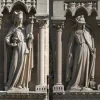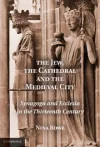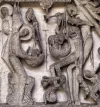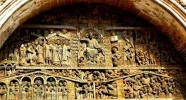more on iconography
PILGRIMSPLAZA said:
The main question on the Synagoga-Ecclesia motif and an iconographic program stays. The bishop must have approved of it before Mateo could begin such a major project.
Georgiana King writes in only a dozen places in
The Way of Saint James on iconography:
- "1. Iconography - 2 . Chronology - 3. The Cult of Santiago - It has taken seven years of my life. The writer's contribution, in particular, is first, a record and interpretation of iconographic detail all along the way, e. g., at Leyre from observation, at Santiago from Aymery Picaud's account; second, an attempt to date, by comparison with such dated examples as exist, without any à priori; third and last, an occasional small hypothesis and the ground for it, e. g., about the original west front at Compostella, and the cult of Santiago.
- Of the portal I am entitled to speak in some detail, as to iconography and style both, for I spent the best part of a day in watching it.
- Into the remaining space on this side the Annunciation and Visitation have been tucked away. In the former the angel, in accordance with Byzantine iconographic use, has one wing folded back over his shoulder like a cloak, and the other stretched out behind his outstretched hand which holds a cross a beautiful bit of symbolism that I do not recall elsewhere. Over the Visitation broods the Holy Ghost.
- The iconography of the capitals is French is French of France but the symbolism is original and exquisite in its arrangement of correspondences, bringing the Epiphany, the Manifestation of God's Humanity, into relation with the Resurrection, the Manifestation of His Divinity; and, in the same way, the Annunciation to Mary that the close of Eve's long expectation was at hand, into relation with the Apparition of the King of Glory in Limbo, to take up with Him the spirits in prison. The main figures of the tympanum are of the later cathedral tradition. The little figures stuck against the mouldings, with the structural irrelevance that nobody could break a Spaniard of, are Spanish motives, perhaps: they left their mark on churches in Navarre and Navarrese painters as well.
- It looks almost as if copied from embroidery, rather than developed in a strong iconographic tradition.
- None of this work recalls in the least that of Toulouse. The iconography of the scene last mentioned is that of Provence.
- Sr. Lopez Ferreiro's identification of them does not correspond with the figures at Orense, where, in all other respects, the imitation was close, nor yet does it agree with what is known of the iconography of the Apostles in Eastern and Spanish art.
- They introduced new conceptions into the west and under their influence religious architecture, the decorative arts, religious iconography, and also religious ideas penetrated from the east into Gaul and Italy
- The cult-image of Jupiter Heliopolitanus, swathed in a long strange strait-waist-coat, and flanked by a pair of bulls, 34 might well give occasion to the effigy as iconography misunderstood brings forth hagiography of the mummy of S. James in the ox-cart.
Furthermore, it corresponds exactly, of course, to the statue of S. Isidore the Ploughman with his insignificant oxen by his side, as we saw that at Cacabelos. I hope I have proved satisfactorily that S. Isidore the Ploughman is only one aspect of Doctor Egregius, cut off like a gardener's slip and set to grow alone; and that the greater Isidore is still only a surrogate of S. James.
- At this point the Byzantine tetramorph, there inside, should be recalled. The mixture is just what we should expect of an old place, once important, seated on a Roman and a pilgrim road : traditions of Aragon, of Constantinople, are grafted on that of Languedoc, in the iconography and thefacture; and the scheme of the whole, while in the main determined by that of Angoumois, was altered by the current we have encountered at Estella and at Carrion. Though the little tympanum in the eighteenth century was over the door, probably that, in the beginning, had none, like Saintes and Bordeaux and Aulnay and the original Civray. The tympanum should belong to a side door, as at Leyre and Huesca.
- DIDRON, A. N. and DURAND, PAUL. Christian Iconography. Translated by Margaret Stokes. London, 1886.
- STUART, DONALD CLIVE. The Stage Setting of Hell and the Iconography of the Middle Ages. Romanic Review, IV, 1913. "
At least now we see how iconography worked in professor King’s days. Apparently there was no written prescription for the Gloria? I’m going on holiday now. I’ll fill in the location of the quotes later. May it in the meantime encourage you to read Mrs. King’s inspiring masterpiece…
-
http://www.archive.org/details/wayofsai ... 01kinguoft - Volume I
-
http://www.archive.org/details/wayofsai ... 02kinguoft - Volume II
-
http://www.archive.org/details/wayofsai ... 03kinguoft - Volume III
Enjoy!



















